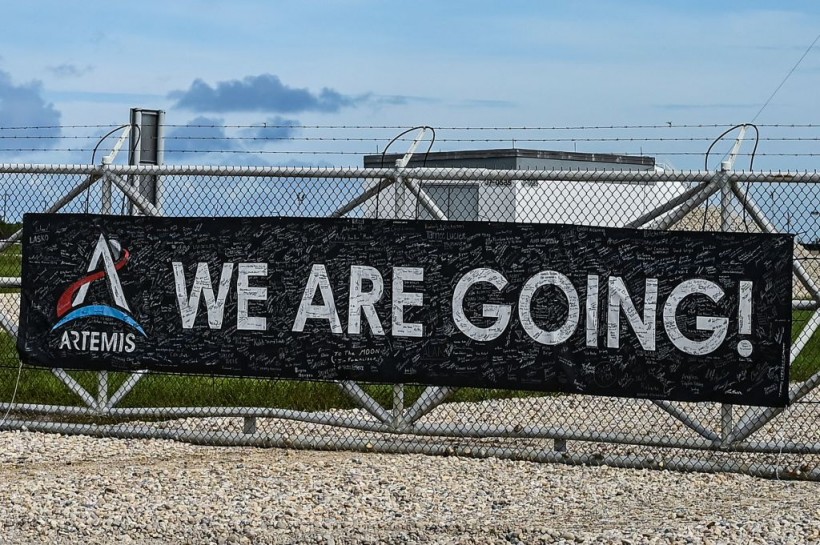NASA's Space Launch System (SLS) rocket remained on track for its flight test on Monday, August 29, despite a series of lightning strikes at the launch pad last weekend.
The 322-foot (98-meter) moon rocket arrived at the launch pad on August 17, drawing crowds of workers at the space centers who mostly were not yet born when NASA sent astronauts to the Moon five decades ago. It took 10 hours for the rocket to make the four-mile trip to the launch pad.

A board covered in people's signatures is displayed near the Artemis I unmanned lunar rocket launch pad at the Kennedy Space Center in Cape Canaveral, Florida, on August 25, 2022, ahead of its launch on August 29.
Staying On Track for the Flight Test
Astronauts could return to the Moon in a few years if the Artemis I mission goes well. However, NASA officials caution that risks are high that could end the flight and cut it short.
According to Phys.org, NASA has put three test dummies into the Orion capsule that will measure vibration, acceleration, and radiation hazards in deep space. The Orion capsule also has more than 1,000 sensors to measure these things in deep space.
Officials from the space agency announced on Sunday that the capsule and ground equipment did not suffer any significant damage during the thunderstorm on Saturday.
About five lightning strikes hit the 600-foot (183-meter) lightning-protection towers that surround the rocket at Kennedy Space Center and the strikes were not strong enough to require additional testing. NASA senior test director Jeff Spaulding noted that the system worked as designed.
Weather forecasters gave 80% odds of acceptable weather on Monday morning, although it might deteriorate during the two-hour launch window as more storms are expected.
Spaulding added that their team did their best over the past months to eliminate any fuel leaks, and conducted tests earlier this year to repair leaking valves to ensure that the rocket will be ready. In case the launch on Monday will fail, the next launch will be on Friday, September 2. The launch team was thrilled to finally be so close to launching the Artemis I mission after years of delays and setbacks.
NASA aims to follow the Artemis flight in 2024 that would carry four astronauts around the Moon. Then by 2025, the first person of color and first woman is envisioned to walk on the lunar surface for the first time.
ALSO READ: NASA's Artemis I Test Flight Making A Giant Leap of Bringing Humans Back to the Moon
Reminders For Launch Day
The test flight of NASA's Artemis I mission is one of the most anticipated in years and so the Kennedy Space Center has released some important information and guidelines for launch day.
The visitor complex opens the parking lot at 3:30 AM, while the main entrance opens 30 minutes later. Heavy traffic is expected in the area, especially between 5 to 10 AM, so it is best to check traffic maps to plan the route to take.
Tickets should be presented at NASA security checkpoints, and those without one will not be permitted to proceed toward the visitor complex. Access to the complex is permitted via State Road 405 in Titusville or State Road 3 in Merritt Island. Once there, park in guest parking and proceed to the entrance.
Check out the items allowed and not permitted on the property on launch day on the space center's website. In case of the date changes, NASA reminds us to keep the tickets as it will be required to access the visitor complex on subsequent launch attempt days.
RELATED ARTICLE: NASA Artemis I Mission: How to Watch Maiden Space Launch System (SLS) Rocket Launch
Check out more news and information on Artemis Program in Science Times.










!['Cosmic Glitch' in Einstein's Theory of General Relativity Could Be Explained in This New Scientific Tweak [Study]](https://1721181113.rsc.cdn77.org/data/thumbs/full/53435/258/146/50/40/cosmic-glitch-in-einsteins-theory-of-general-relativity-could-be-explained-in-this-new-scientific-tweak-study.jpeg)



